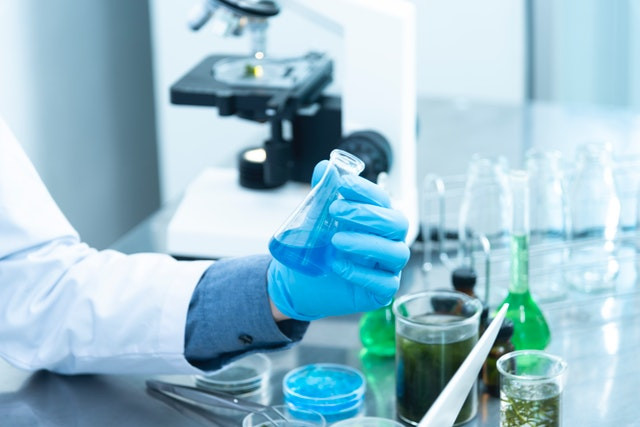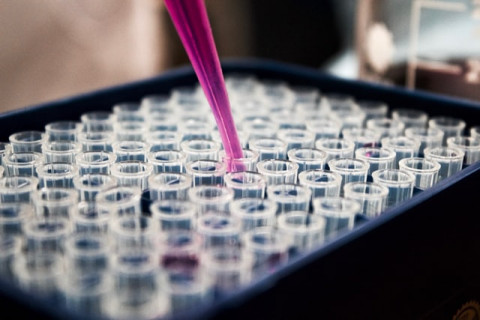
10 min
2
10.04.2022

All About Chromatography Experiments
The significant purpose of chromatography is the separation of mixtures. It mainly deals with samples of liquids and gases. This technique uses the binding properties of various molecules. It is possible to separate molecules from a mixture. You can consider dyes as an example. Textile dyes come in a range of bright colors. Secondary colors present in dyes are made by combining primary colors.
Through chromatography, you can separate individual colors according to their relative bond strengths. Chromatography lab reports can be crucial in both qualitative and quantitative analysis. Besides, you may even distinguish organic from an inorganic sample using this experiment. The process comprises a mobile phase and a stationary phase. In the mobile phase, the sample passes through rubbing alcohol or water. Then you use a filter paper or towel through which you pass the mixture.
Purpose Of Paper Chromatography Experiments
In paper chromatography, you can interpret and analyze two or more separable mixtures. A chromatography lab report is crucial in forensics and crime investigations. You can identify a compound that is poisonous or may aid in committing the crime. Paper chromatography is useful in the pharmaceutical industry as it helps in the analysis of compounds in drugs, making it easy for doctors to prescribe appropriate medication to the patient.
You can also separate color pigments from various mixtures, which is useful in isolating many plant pigments. During a reaction, the amount of reactants and products is inversely proportional. It means that as a reaction proceeds, the reactants decrease, and the amount of products increases. You can use paper chromatography to detect a reaction's rate by developing a chromatogram during intervals and maintaining a record.
Lab Report Essential Parts
After completing a lab or medical procedure, we present all the results, using a lab report. It gives us details about the tests and shows the importance of an experiment. Writing a lab report makes it easy for you to make sense of the results and connect the dots to come up with the correct diagnosis.
A lab report starts with a title page covering the name, student number, and experiment name. In this case, the title will be paper chromatography. Next in line is the abstract that summarizes the significant points. It would help determine why you are experimenting and state the materials you need to perform the task. You may also include the results and put forward your stance on the significance of those results.
Introduction
Paper chromatography is a simple technique in which you separate compounds to get an idea about the components. When writing a lab report, you need to follow a standard pattern to make the report presentable. Start the report with an introduction that covers the purpose or reason for setting up the experiment.
In specific circumstances, you may even add some background in your introduction or elaborate about the experiment. Maintain a formal tone but avoid using complex vocabulary. The report should be reader-friendly, and the introduction should comprise one paragraph. An introduction is a section where you place your hypothesis or elaborate on your idea to test through the experiment.
Materials
Materials are an integral part of the lab report. After the introduction, you will have to state all the materials you will use in the experiment. It is significant as it gives the reader an idea about the nature of an experiment. It is a standard to state all the materials used so that it is feasible to re-conduct the experiment.
A report is vague and incomplete if the heading of materials is absent. It is wise to state the things used in bullet form as it shows neatness and it is easy to read. Writing the materials in a paragraph is also acceptable as long as you cover all the crucial points. Following is an example of a list of materials for a paper chromatography experiment:
- Gloves;
- Goggles;
- Lab coat;
- Filter paper;
- Toothpick;
- Ninhydrin solution;
- Known substances like amino acids;
- Samples that we need to identify/ separate.
Methods
This heading sets the tone of your report. You will mention all the steps you take to execute the experiment successfully. You have to make sure that you write the method with such details that anyone who reads it should repeat the experiment without discomfort.
Write your method in a directional tone as if you are giving instructions to experiment. It would help if you adopted such a way of writing that the reader does not have to ponder on your instructions to interpret the meaning. Even if it seems insignificant to you, add every step, never know if the reader will be a professional laboratorian or an inexperienced person.
For example, if you perform a chromatography experiment, you will describe the three phases in the procedure, and you must follow the steps in the given order. You will further describe the method of preparation in which you will create a baseline and make markings on a filter paper to identify your creation.
You will write about your markings on the baseline 1.7cm from the shorter left edge and 1.0 cm from the bottom of the longer edge. Later, you will discuss pigmenting the sample and even state when you observe the color spread. In the methods section, you also scribe the time you spend on a step, for example, letting the chemical cool down for five minutes or so.
Data And Results
After you complete the chromatography procedure, you need to present the results in an organized manner. The data should be reader-friendly and written so that the doctor or practitioner can easily understand the readings. It is wise to present the data in tabulated form as it saves up space and makes it easy for the reader to access the desired value. Make four columns with the headings like amino acids, solvent distance, spot distance, and retardation factor or rf value.
It is better to start plotting with known substances and record their retardation factor (rf) values.
You can then add the data collected into respective columns and present the results. You can highlight the column headings and put numbers next to every substance that you work on. Finally, you can add an image of your chromatograph to make the report thorough. This will make it possible for the reader to get your results from the table. The chances of error will reduce, and the experiment results will become genuine.
Discussion/Analysis
The data that you collect will include the distance covered by the solvent and the spot. By using these values, you will now calculate the rf numbers. This experiment shows a clear relationship between the amino acids and the samples by considering the rf values. You can then work out the purity of a sample or identify a drug or dye in a plant. If the spots of a substance and a specimen are on the same mark, you can calculate that the specimen is pure.
If the spot falls elsewhere, we can find out the impurity. This is useful in the pharmaceutical industry during the manufacture of various medicines. You can also use paper chromatography in the textile industry when developing colorful dyes for the pattern and designs in fabric. Paper chromatography analysis can also be used to check if a particular product can meet the standard requirement. Many products have to pass a paper chromatography test before coming into the market.
Conclusions
Now that we have our data and results, we will get an insight into various samples. In conclusion, you add the critical finding. It is going through the data and analyzing our values. You come up with a decision and state your verdict. In conclusion, you write an answer to the question for which you experimented in the first place. For example, you will realize whether the drug tested is pure or contains impurities. You can also come up with the decision of whether the medication is suitable for the patient or not.
In the forensics department, your conclusion is crucial as it helps identify poisons and catch the killer. Under this section, you can add any limitation that you think may affect your experiment's results. You can further mention measures that you can take in the future to eliminate those limitations. For example, you can state if the mixture was too complex for paper chromatography to produce authentic results. Then you can suggest if you can perform any other experiment to work your answer. You may even compare the results from both experiments to ensure accuracy. You also need to make sure that you use minute sample amounts on the chromatography paper as sample abundance on the chromatogram is a big no. It compromises your results and gives vague readings.
Chromatography Definition
Chromatography is a means of separating components of a mixture. All the molecules have their specific kinetic energies due to which they are continuously exchanging between two phases, namely stationary and mobile phases. When you place the mixture on the filter paper, the mobile phase molecules tend to move away from those who retain in the stationary phase for more extended periods. The ratio of particles in the mobile and stationary phase in a region is directly proportional to those particles' concentration.
This phenomenon is called the partition coefficient and is the foundation upon which chromatography is performed. After you introduce the filter paper sample, different molecules travel up the paper in the direction of fluid flow at different rates. The moving fluid is the source due to which the solute moves, but a time comes when the resistive force of solute affinity overcomes it for the stationary phase. As these two forces interact and are played with by the analyst, this produces separation. Other than chromatography, electrophoresis is also an alternate method to use in separating substances.
Chromatography With The Help Of Water-Soluble Markers
You use paper chromatography on water-soluble samples. With an insoluble sample, you will not be able to separate its components on a filter paper. A good example is a water-soluble marker that you can test as a fun experiment. Since their pigments can be soluble in water, you can perform chromatography on them and separate their components. You can also identify the different colors combined in the water-soluble marker. Paper chromatography using water-miscible markers can be used to teach kids about the primary and secondary colors while introducing chromatography simultaneously.
Workings Of Paper Chromatography
In paper chromatography, you soak a filter paper in a moving solvent to separate its components. The working of this procedure is quite simple. It begins with dropping a sample at one end of the filter paper and allowing it to dry. After the sample spot dries, you submerge the filter paper's end nearest to the spot in a moving solvent presumably, water or rubbing alcohol.
Having said that, there are a few limitations to this procedure. For instance, you need to ensure that you do not accidentally dip the spot in the moving solvent as it can damage the experiment. The readings then will hold no value, and you will have to experiment again from the start. Paper chromatography works in both ascending and descending pools. In the ascending pool, the solvent travels up the capillarity. Whereas in a descending pool, gravity also helps in moving the fluid downwards along with capillarity.
Chromatography Using Black Ink
Suppose you want to indulge your kids in science and boost their interest in separation techniques. In that case, black ink chromatography is a little fun activity you can perform with your kids. The preparation is easy, and the setup is the same as typical paper chromatography. You can use water as a solvent, and the only difference is that you will use black ink as your sample. As the water passes through black ink, you will observe a beautiful spectrum of colors. This will pique the children’s interest, and they will want to learn more on the subject.
Applications For Paper Chromatography
Paper chromatography is a form of forensic science helping with the investigation of crimes. You can further analyze food colors in ice creams, beverages, jellies, jams, and other sweet drinks using this procedure. You may need to examine various amino acids and carbohydrates from complex organic compounds. This is also possible due to paper chromatography. This gives you information about the presence of specific molecules in food or drugs. It also becomes easy for the doctors to prescribe the right medication or a therapist to get an idea about your medicine and provide treatment accordingly.



